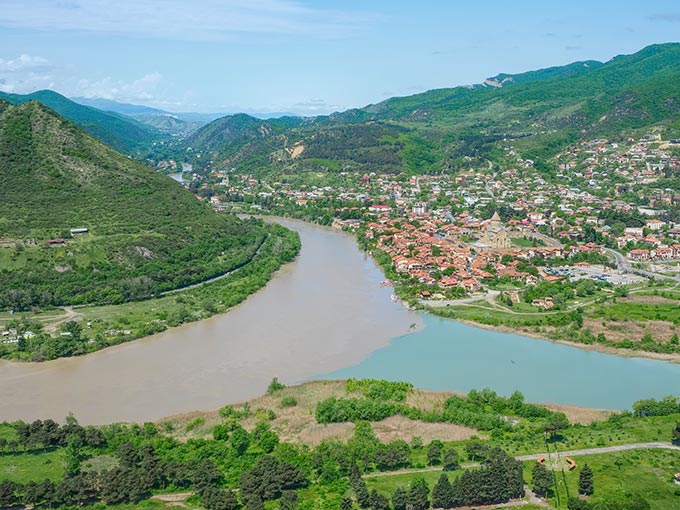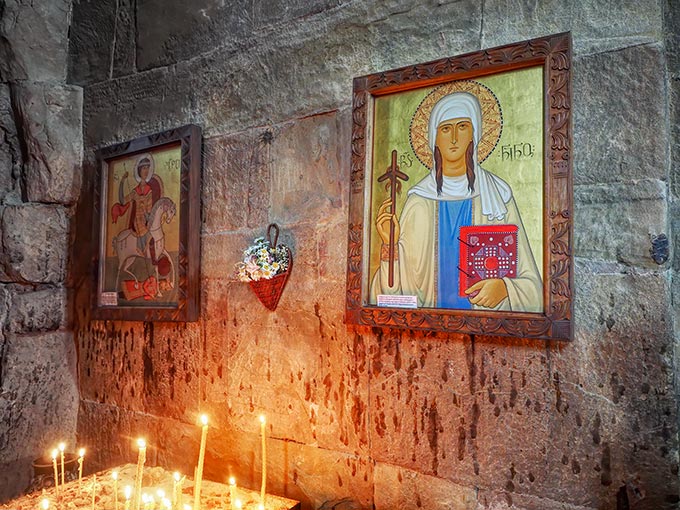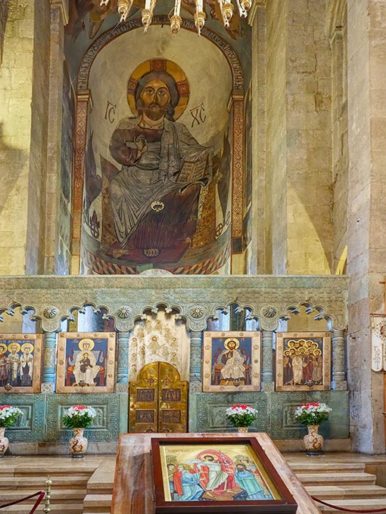Mtskheta, the original capital of Georgia, is one of the oldest continuously inhabited cities in the world and the place where the country first adopted Christianity in 334. Today, not only is it the headquarters of the Georgian Orthodox and Apostolic Church, it is home to Jvari Monastery and Svetitskhoveli Cathedral, two important religious sites included in the UNESCO listed Historical Monuments of Mtskheta. Those of you who have read my review of Tbilisi, Georgia, will already know that I was less than enthusiastic about a city that is the darling of many travel writers. Fortunately, visiting Mtskheta allowed me to see a different and more redeeming side of Georgia.

My tour began at the Jvari Monastery (Monastery of the Holy Cross), which stands atop a rocky hill, overlooking the confluence of the Mtkvari and Aragvi rivers and the town of Mtskheta. In 4th century, Mother Mary appeared to Saint Nino, a Cappadocian female missionary, and instructed her to spread Orthodox Christianity among the pagan-worshiping population of Georgia. St. Nino succeeded in converting the Georgian queen Nana, but King Mirian III stubbornly clung to his pagan beliefs. According to legend, the King was blinded during a hunting trip, when darkness suddenly fell upon the land. The light, and his sight, were restored only after he prayed to “Nino’s God.” King Mirian converted soon thereafter and ordered Christianity to be the State religion.

With the support of the King, St. Nino erected a large wooden cross on the top a hill where a pagan temple had stood. Pilgrims from all over the Caucasus made the journey to Mttskheta to pray before the cross, which was said to perform miracles. A small church was erected over the remnants of the wooden cross in 545, but the popularity of the pilgrimage site soon demanded a larger structure. The second church, constructed upon the hill between 590 and 605, is the present-day Jvari Monastery.

I climbed the wind-blasted hill and squeezed into the crowded front apse of the 1,415-year old Cruciform church. The small, semi-circular space was lit only by flickering candles and narrow beams of light streaming in from four tiny arched openings below the high domed ceiling. Gradually, my eyes adjusted to the dim light. People milled about, whispering prayers as they lit candles in front of the monastery’s two revered icons: St. George the Dragon Slayer on the left and St. Nino on the right. At the center of the apse, a modern wooden cross mounted on an octagonal base soared upward toward the lofty dome. The remains of the original wooden cross of St. Nino are said to be entombed in the base.

From the hilltop we descended to Svetitskhoveli Cathedral, located in the center of the quaint town of Mtskheta. We wound through kiosks selling local products as my guide, Tamari, told me about the local culture and some of the items on display. At one kiosk, she insisted that I taste “Georgian Snickers.” These Churchkhela, as they are known locally, are long strands of nuts and dried fruits covered in a chewy fruit coating. Delicious! I bought a bag of them to snack on after dinner. The same vendor enticed me to buy a jar of her special salt mixed with secret spices. It smelled heavenly and when she said it was great with potatoes I could literally taste the potatoes.

A bit further on, Tamari picked up a Panduri, the national instrument of Georgia, and proceeded to strum a tune on it. When I insisted I had no musical talent, she plopped a Papakhi on my head, the fluffy ball of sheep fur that serves as the national hat. I laughed but kindly declined. I’m not likely to be traveling in places that are cold enough to require fur hats.

Having run the gauntlet of vendors, we arrived at one of two massive stone archways that serve as entrances to Svetitskhoveli Cathedral. The mythos surrounding this church is even more impressive than the legend of St. Nino. In the first century, Elias, a Georgian Jew from Mtskheta, claimed to purchased the Robe of Jesus after witnessing Christ’s crucifixion. Elias brought the robe to Georgia and handed it to his sister, Sidonia. Overcome with emotion, she collapsed and died. When the robe could not be removed from her grasp, she was buried with it on the spot where she died. A Cypress tree grew on her grave and people began to report that they had been cured of diseases after standing beneath its boughs.

King Mirian decided to build a church on the site. He cut down the Cypress, shaping it into seven columns to be used as foundation pillars for the church. One of the seven magically floated up in the air, returning to earth only after St. Nino prayed through the night. A sacred liquid that cured people of all diseases was said to flow from the column. Today the name of the cathedral reflects this legend. Sveti means “pillar” in the Georgian language, and tskhoveli means “life-giving” or “living.”

The original Svetitskhoveli Cathedral was built during the 4th century. That first church was destroyed, but the grave containing the Robe of Jesus was not. The current cathedral was built in the 11th century by the Catholicos Patriarch Melchisedek (leader of Orthodox religion), along with King George I. After the cathedral was completed, the king ordered that the the right hand of the architect, Arsukidze, be cut off. Officially, the king stated that cutting off the architect’s hand would ensure that he could never again create a church as beautiful as Svetitskhoveli. But others insisted the architect’s hand had been cut off as punishment because he loved the same woman as the king.

A carving of the architect’s hand and forearm, grasping a chisel, is still visible below the peak of the cathedral roof. Two inscriptions on the exterior of the cathedral refer to Arsukidze. The first, directly below the carving of the hand and forearm, says, “The Hand of Arsukidze, slave of God, may forgiveness be his.” A second, engraved on the eastern facade, states, “This holy church was built by the hand of Thy wretched servant, Arsukidze. May your soul rest in peace, O Master.” It is clear that Arsukidze did not live to see his masterpiece finished. Methinks the king did more than cut off his hand!

The interior of Svetitskhoveli Cathedral is much grander and better lit than Jvari Monastery. Unfortunately, most of the original frescoes were destroyed during the 19th century when Georgia was under the influence of Emperor Nicholas of Russia. Almost all of the original icons have been removed to museums. Even the enormous painting of Jesus that rises from behind the Iconostasis was painted by a Russian artist during the 19th century. However, it does contain graves of at least ten Georgian kings, the remnant’s of the life-giving wooden column, the grave of Sidonia, and the robe of Jesus, which is entombed beneath a 17th-century ciborium. The robe alone makes Svetitskhoveli Cathedral the second most sacred place in the world to Christians, after the Church of Jerusalem.

As UNESCO listed Historical Monuments, both Svetitskhoveli Cathedral and Jvari Monastery are popular tourists sites in Georgia. But unlike Georgia’s capital city, Tbilisi, neither site felt over-touristy. In fact, quite the opposite was true. Though there were many tourists at both sites, the overwhelming majority of visitors were local folks who had come to pray or make devotions, just as they have been doing for the past 1,400 years. I’m quite sure that Georgian destinations beyond Tbilisi have much more to offer. I look forward to a return visit, when I can explore the countryside and immerse more fully into traditional Georgian culture.
You may also enjoy:
The Secret Erotic Art of Pompeii and Herculaneum
Miracle Cure in the Thermal Baths of Banos, Ecuador
The Magnificent Rock-Hewn Churches of Lalibela, Ethiopia

Thank you Barbara ? ? fir your great article as I will definitely add Mtskheta to spend time there. You are a blessing ? ? ?? ?
Rene
Thank you Barbara ? ? fir your great article as I will definitely add Mtskheta to spend time there. You are a blessing ? ? ?? ?
Rene
This is a great article, but the “influence of emperor Nicholas is completely wrong. Tsar Nicholas and his entire family were executed by the Soviets in 1917. Georgia was captured by the Soviets in 1921….
your photographs are amazing ?????? nice read too…
Thank you so much Anas!
Hi Barbara, As historically and visually interesting as the religious sites of Mtskheta already are, the ancient myths and legends attached to them add more to their attraction, especially that of Jesus’ robe. Another country to add to my travel wish list. Glad you found your visit to Mtskheta’s sites rewarding and hope you enjoyed your time there. Your photos, as always, are really superb!
Thanks so much Sylvia. It’s always gratifying to hear that some people actually take the time to read what I write. Makes me want to keep on writing! 🙂 AND taking photos, of course.
A very interesting read. Also a very interesting country- glad I read this post.
Many thanks,
Thanks Irene. It’s not a well known destination, but all three of the countries in the Caucasus are well worth a visit.
I have had interest in Georgia for some time and was thrilled to get pictures/info about this part of our world. Thank you…
Ruby Kidd
Hi Ruby: Hope you also read my previous article about the Georgian capital of Tbilisi.
Great commentary and photos. Had to cancel our trip last year to Armenia and Georgia because of tensions with Iran and USA. Now this year the virus. Maybe some day but I am getting older and can’t wait much longer.
Hi Lynda: I found the entire Caucasus region to be absolutely fascinating. Keep a lookout, because the next few weeks I’ll be publishing stories about Azerbaijan and Armenia as well.
Barbara, how neat. Georgia came up on our radar screen literally yesterday. We are researching places to travel to in 2021. Doors are very open there. Love and hugs.
Hi Ryan: Doors are indeed very open. Americans get a one year visa upon arrival. The countryside is lovely, as are the people, but I found Tbilisi to be over-touristy and wasn’t as “wowed” by it as others who seem to love it. I’ll be interested to hear your opinion after you visit.